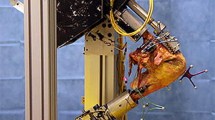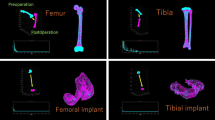Abstract
Introduction
Unicompartmental knee arthroplasty (UKA) and total knee arthroplasty (TKA) are standard procedures for treating knee joint arthritis. Neither UKA nor TKA seems to be optimally suited for patients with bicompartmental osteoarthritis that affects only the medial and patellofemoral compartments. A bicompartmental knee arthroplasty (BKA) was designed for this patient group. This study aimed to compare the effectiveness of a BKA and TKA in restoring the kinematics of the knee joint.
Materials and methods
In this in vitro study, three types of knee arthroplasties (BKA, posterior cruciate ligament-retaining, and posterior cruciate ligament-resecting TKA) were biomechanically tested in six freshly frozen human cadaveric specimens. Complete three-dimensional kinematics was analyzed for each knee arthroplasty during both passive and loaded conditions in a validated knee kinematics rig. Infrared motion capture cameras and retroreflective markers were used for recording data.
Results
No significant differences could be found between the three types of arthroplasties. However, similar kinematic changes between BKA and a native knee joint were documented under passive conditions. However, in a weight-bearing mode, a significant decrease in femoral rotation during the range of motion was found in arthroplasties compared to the native knee, probably caused by contraction of the quadriceps femoris muscle, which leads to a decrease in the anterior translation of the tibia.
Conclusions
Kinematics similar to that of the natural knee can be achieved by BKA under passive conditions. However, no functional advantage of BKA over TKA was detected, which suggests that natural knee kinematics cannot be fully imitated by an arthroplasty yet. Further prospective studies are required to determine the anatomic and design factors that might affect the physiologic kinematics.



Similar content being viewed by others
References
Varacallo MA, Herzog L, Toossi N, Johanson NA (2017) Ten-year trends and independent risk factors for unplanned readmission following elective total joint arthroplasty at a large urban academic hospital. J Arthroplasty 32:1739–1746. https://doi.org/10.1016/j.arth.2016.12.035
Booth RE Jr (2001) The posterior stabilized: a knee for all seasons. Orthopedics 24:887–888
Clark CR, Rorabeck CH, MacDonald S, MacDonald D, Swafford J, Cleland D (2001) Posterior-stabilized and cruciate-retaining total knee replacement: a randomized study. Clin Orthop Relat Res 392:208–212. https://doi.org/10.1097/00003086-200111000-00025
Daniilidis K, Holl S, Gosheger G, Dieckmann R, Martinelli N, Ostermeier S, Tibesku CO (2013) Femoro-tibial kinematics after TKA in fixed- and mobile-bearing knees in the sagittal plane. Knee Surg Sports Traumatol Arthrosc 21:2392–2397. https://doi.org/10.1097/00003086-200111000-00025
Victor J, Banks S, Bellemans J (2005) Kinematics of posterior cruciate ligament-retaining and -substituting total knee arthroplasty: a prospective randomised outcome study. J Bone Joint Surg Br 87:646–655. https://doi.org/10.1302/0301-620X.87B5.15602
Insall JN, Ranawat CS, Aglietti P, Shine J (1976) A comparison of four models of total knee-replacement prostheses. J Bone Joint Surg Am 58:754–765. https://doi.org/10.2106/00004623-197658060-00003
Walker PS, Sathasivam S (2000) Design forms of total knee replacement. Proc Inst Mech Eng H 214:101–119. https://doi.org/10.1243/0954411001535282
Gemayel AC, Varacallo M (2019) Total knee replacement (TKR) techniques (updated 24 Feb 2019). In: StatPearls [Internet]. StatPearls Publishing, Treasure Island. https://www.ncbi.nlm.nih.gov/books/NBK538208/
Sheth NP, Husain A, Nelson CL (2017) Surgical techniques for total knee arthroplasty: measured resection, gap balancing, and hybrid. J Am Acad Orthop Surg 25:499–508. https://doi.org/10.5435/JAAOS-D-14-00320
Andriacchi TP, Dyrby CO (2005) Interactions between kinematics and loading during walking for the normal and ACL deficient knee. J Biomech 38:293–298. https://doi.org/10.1016/j.jbiomech.2004.02.010
Müller W (1982) Das Knie: Form, Funktion und ligamentäre Wiederherstellungschirurgie Wiederherstellungschirurgie. Springer, Berlin
Goodfellow J, O’Connor J (1978) The mechanics of the knee and prosthesis design. J Bone Joint Surg Br 60B:358–369. https://doi.org/10.1302/0301-620X.60B3.581081
Goodfellow J, O’Connor J (1992) The anterior cruciate ligament in kneearthroplasty. A risk-factor with unconstrained meniscal prostheses. Clin Orthop Relat Res 276:245–252
Ledingham J, Regan M, Jones A, Doherty M (1993) Radiographic patterns and associations of osteoarthritis of the knee in patients referred to hospital. Ann Rheum Dis 52:520–526. https://doi.org/10.1136/ard.52.7.520
Victor J, Van Glabbeek F, Vander Sloten J, Parizel PM, Somville J, Bellemans J (2009) An experimental model for kinematic analysis of the knee. J Bone Joint Surg Am 91:150–163. https://doi.org/10.2106/JBJS.I.00498
Zavatsky AB (1997) A kinematic-freedom analysis of a flexed-knee-stance testing rig. J Biomech 30:277–280. https://doi.org/10.1016/S0021-9290(96)00142-X
Victor J, Labey L, Wong P, Innocenti B, Bellemans J (2010) The influence of muscle load on tibiofemoral knee kinematics. J Orthop Res 28:419–428. https://doi.org/10.1002/jor.21019
Grood ES, Suntay WJ (1983) A joint coordinate system for the clinical description of three-dimensional motions: application to the knee. J Biomech Eng 105:136–144. https://doi.org/10.1115/1.3138397
Freeman MA, Pinskerova V (2003) The movement of the knee studied by magnetic resonance imaging. Clin Orthop Relat Res 410:35–43. https://doi.org/10.1097/01.blo.0000063598.67412.0d
Freeman MA, Pinskerova V (2005) The movement of the normal tibio-femoral joint. J Biomech 38:197–208. https://doi.org/10.1016/j.jbiomech.2004.02.006
Hill PF, Vedi V, Williams A, Iwaki H, Pinskerova V, Freeman MA (2000) Tibiofemoral movement 2: the loaded and unloaded living knee studied by MRI. J Bone Joint Surg Br 82:1196–1198. https://doi.org/10.1302/0301-620X.82B8.0821196
Leffler J, Scheys L, Planté-Bordeneuve T, Callewaert B, Labey L, Bellemans J, Franz A (2012) Joint kinematics following bi-compartmental knee replacement during daily life motor tasks. Gait Posture 36:454–460. https://doi.org/10.1016/j.gaitpost.2012.04.008
Rolston L, Siewert K (2009) Assessment of knee alignment after bicompartmental knee arthroplasty. J Arthroplasty 24:1111–1114. https://doi.org/10.1016/j.arth.2008.07.006
Wang H, Dugan E, Frame J, Rolston L (2009) Gait analysis after bi-compartmental knee replacement. Clin Biomech 24:751–754. https://doi.org/10.1016/j.clinbiomech.2009.07.014
Müller M, Matziolis G, Falk R, Hommel H (2012) The bicompartmental knee joint prosthesis Journey Deuce: failure analysis and optimization strategies. Orthopade 41:894–904
Palumbo BT, Henderson ER, Edwards PK, Burris RB, Gutiérrez S, Raterman SJ (2011) Initial experience of the Journey-Deuce bicompartmental knee prosthesis: a review of 36 cases. J Arthroplasty 26:40–45
Dudhniwala AG, Rath NK, Joshy S, Forster MC, White SP (2016) Early failure with the Journey-Deuce bicompartmental knee arthroplasty. Eur J Orthop Surg Traumatol 26:517–521. https://doi.org/10.1007/s00590-016-1760-4
Banks S, Bellemans J, Nozaki H, Whiteside LA, Harman M, Hodge WA (2003) Knee motions during maximum flexion in fixed and mobile-bearing arthroplasties. Clin Orthop Relat Res 410:131–138. https://doi.org/10.1097/01.blo.0000063121.39522.19
Bellemans J, Banks S, Victor J, Vandenneucker H, Moemans A (2002) Fluoroscopic analysis of the kinematics of deep flexion in total knee arthroplasty. Influence of posterior condylar offset. J Bone Joint Surg Br 84:50–53. https://doi.org/10.1302/0301-620X.84B1.0840050
Chouteau J, Lerat JL, Testa R, Moyen B, Fessy MH, Banks SA (2009) Kinematics of a cementless mobile bearing posterior cruciate ligament-retaining total knee arthroplasty. Knee 16:223–227. https://doi.org/10.1016/j.knee.2008.11.008
Dennis DA, Komistek RD, Colwell CE Jr, Ranawat CS, Scott RD, Thornhill TS, Lapp MA (1998) In vivo anteroposterior femorotibial translation of total knee arthroplasty: a multicenter analysis. Clin Orthop Relat Res 356:47–57. https://doi.org/10.1097/00003086-199811000-00009
Dennis DA, Komistek RD, Mahfouz MR, Walker SA, Tucker A (2004) A multicenter analysis of axial femorotibial rotation after total knee arthroplasty. Clin Orthop Relat Res 428:180–189. https://doi.org/10.1097/01.blo.0000148777.98244.84
Harman MK, Banks SA, Kirschner S, Lutzner J (2012) Prosthesis alignment affects axial rotation motion after total knee replacement: a prospective in vivo study combining computed tomography and fluoroscopic evaluations. BMC Musculoskelet Disord 13:206. https://doi.org/10.1186/1471-2474-13-206
Innocenti B, Pianigiani S, Labey L, Victor J, Bellemans J (2011) Contact forces in several TKA designs during squatting: A numerical sensitivity analysis. J Biomech 44:1573–1581. https://doi.org/10.1016/j.jbiomech.2011.02.081
Kuroyanagi Y, Mu S, Hamai S, Robb WJ, Banks SA (2012) In vivo knee kinematics during stair and deep flexion activities in patients with bicruciate substituting total knee arthroplasty. J Arthroplasty 27:122–128. https://doi.org/10.1016/j.arth.2011.03.005
Most E, Zayontz S, Li G, Otterberg E, Sabbag K, Rubash HE (2003) Femoral rollback after cruciate-retaining and stabilizing total knee arthroplasty. Clin Orthop Relat Res 410:101–113. https://doi.org/10.1097/01.blo.0000062380.79828.2e
Daniel DM, Stone ML, Barnett P, Sachs R (1988) Use of the quadriceps active test to diagnose posterior cruciate-ligament disruption and measure posterior laxity of the knee. J Bone Joint Surg Am 70:386–391. https://doi.org/10.2106/00004623-198870030-00010
Mu S, Moro-Oka T, Johal P, Hamai S, Freeman MA, Banks SA (2011) Comparison of static and dynamic knee kinematics during squatting. Clin Biomech 26:106–108
Daniilidis K, Skwara A, Vieth V, Fuchs-Winkelmann S, Heindel W, Stuckmann V, Tibesku CO (2012) Highly conforming polyethylene inlays reduce the in vivo variability of knee joint kinematics after total knee arthroplasty. Knee 19:260–265
Tibesku CO, Daniilidis K, Skwara A, Dierkes T, Rosenbaum D, Fuchs WS (2011) Gait analysis and electromyography in fixed- and mobile-bearing total knee replacement: a prospective, comparative study. Knee Surg Sports Traumatol Arthrosc 19:2052–2059
Price AJ, O’Connor JJ, Murray DW, Dodd CA, Goodfellow JW (2007) A history of Oxford unicompartmental knee arthroplasty. Orthopedics 30:7–10
Banks SA, Fregly BJ, Boniforti F, Reinschmidt C, Romagnoli S (2005) Comparing in vivo kinematics of unicondylar and bi-unicondylar knee replacements. Knee Surg Sports Traumatol Arthrosc 13:551–556
Author information
Authors and Affiliations
Corresponding authors
Additional information
Publisher's Note
Springer Nature remains neutral with regard to jurisdictional claims in published maps and institutional affiliations.
Rights and permissions
About this article
Cite this article
Yao, D., Akram, I., Daniilidis, K. et al. Bicompartmental, medial and patellofemoral knee replacement might be able to maintain unloaded knee kinematics. Arch Orthop Trauma Surg 142, 501–509 (2022). https://doi.org/10.1007/s00402-021-03816-0
Received:
Accepted:
Published:
Issue Date:
DOI: https://doi.org/10.1007/s00402-021-03816-0




